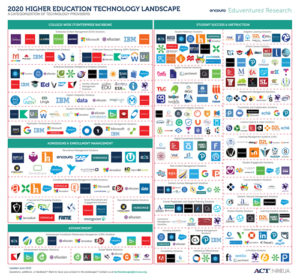The COVID-19 health pandemic has cast a spotlight on virtual learning solutions, institutions’ ability to handle security threats and network demands, and more.
The annual Higher Education Technology Landscape, which categorizes the market of technology products, illustrates how COVID-19 has impacted technology systems.
In an online post, James Wiley, principal analyst at Eduventures, notes that this year’s Landscape reflects some of the biggest challenges higher-ed leaders have had to face during the COVID-19 pandemic.
Related content: 5 top priorities for online students
And while flexible learning models were already on the rise, the abrupt closure of campuses across the globe certainly sped up their use, Wiley says.
The 2020 Landscape, from Eduventures, reflects the heightened demands placed on teaching and learning ecosystems with new emphasis on the following solution categories:
Accessibility Solutions: Institutions now face the challenge of ensuring that students with disabilities can access digital content while learning remotely. By adding the Accessibility Solutions segment to the Landscape, products are identified that help to both create and assess accessible digital content.
Faculty Lifecycle Management Solutions: All institutions track student-level data that gives them insight into things like courses taken or assessments completed. Many do not have similar insight into faculty activities like courses taught or assessments administered. This type of insight is critical when considering how a teaching and learning ecosystem should adapt to changes in modality. The new Faculty Lifecycle Management Solutions segment comprises solutions that help provide this insight.
Institutional Effectiveness Solutions: Education leaders have already begun reflecting on how effective their remote learning efforts were, and whether students performed as well as they would have in an on-campus setting. As institutions seek to learn from these efforts, data and metrics are needed to establish their success or failure. Institutional Effectiveness Solutions support program development and evaluation, efficacy measurement, and ongoing program review.
Student Engagement Solutions: Higher education often uses the term “engagement”, but rarely is there a consistent definition. The Landscape considers engagement to be less about tactical steps and more about the end goal of creating a sense of belonging for students along their journeys. The Student Engagement Solutions segment was added this year to highlight solutions that empowers schools them to engage with students and foster a sense of belonging.
Student Mobility Solutions: Student transferring between institutions is not a recent phenomenon. This process requires students to find information about transfer articulation policies and agreements, research how courses and programs map to potential degrees, and understand which comparable courses are taught at other institutions. Students find themselves retaking courses or choosing the wrong program all too often. Student Mobility Solutions empower both students and institutional leaders to overcome these challenges.
“Any large-scale, catastrophic event–like hurricanes or pandemics–pressure-tests our environment, forcing us to question our readiness to respond and adapt to the challenge before us,” Wiley says. “COVID-19, in particular, has required nearly all institutions to deliver courses and academic support remotely instantaneously, and many institutions have struggled to meet this need. While our overall classification methodology for the Landscape has not changed, we did want to ensure that it captures some of the key challenges arising from institutional responses to COVID-19.”
Wiley added, “Even before the pandemic, we were already seeing an increased focus on building teaching and learning ecosystems that are flexible enough to address potential changes in educational delivery and support. COVID-19 has dramatically exacerbated this need.”
The forthcoming 2020 Higher Education Technology Landscape Report will dive more deeply into the new segments, standout vendors, and how other trends are impacting the Landscape. In the meantime, the 2020 Landscape will serve as a tool toward a better understanding of the current product marketplace.
Material from a press release was used in this report.
- First-generation students are more likely to seriously consider leaving college - April 17, 2024
- How higher ed can meet workforce needs - April 15, 2024
- Higher ed leaders believe continuing education units are undervalued - April 10, 2024

